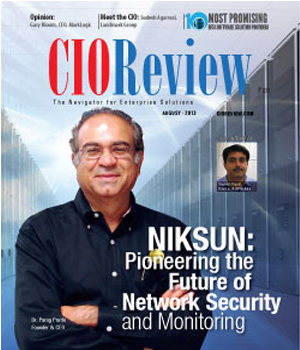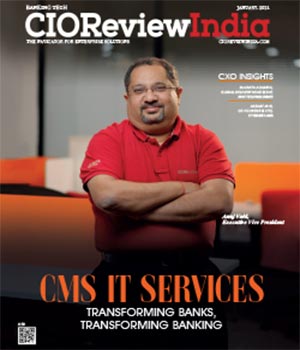
Upcoming Technological Advancements in Payments Banks
Pinak Chakraborty, CIO of Airtel Payments Bank
 In an exclusive interview with CIO TechOutlook, Pinak Chakraborty, CIO of Airtel Payments Bank, shares the complexities associated with simplifying payment processes and how emerging technologies like blockchain and tokenization are set to improve customer experience. He has expertise in digital product development and technology modernization, and he and his engineering team have filed 17 patent applications, with 14 successfully granted by the US Patent Office.
In an exclusive interview with CIO TechOutlook, Pinak Chakraborty, CIO of Airtel Payments Bank, shares the complexities associated with simplifying payment processes and how emerging technologies like blockchain and tokenization are set to improve customer experience. He has expertise in digital product development and technology modernization, and he and his engineering team have filed 17 patent applications, with 14 successfully granted by the US Patent Office.
What are the key benefits of faster payment processing for consumers, and how will emerging payment technologies like contactless payments and mobile wallets enhance this experience?
First and foremost is convenience. Quick transactions mean less time spent at checkout, making the entire process smoother. Customers can complete purchases or pay bills without any delays, which enhances their overall experience.
Another major benefit is real-time updates. Faster processing ensures that customers’ account balances are updated immediately rather than hours later or at the end of the day. This provides them with better financial visibility and helps them manage their money more effectively.
In addition to these, digital payment methods often come with increased security. Emerging technologies like biometric authentication and tokenization enhance safety and protect customers from potential fraud.
Lastly, faster payment processing provides greater flexibility. Customers can pay from anywhere, anytime, and in any format they prefer. Whether it’s contactless cards, mobile wallets, or other options, they can enjoy seamless, on-the-go transactions. Tap-and-go solutions, in particular, offer an effortless shopping experience by eliminating unnecessary steps.
Now, regarding emerging payment technologies, they bring a host of additional benefits. For example, contactless payments allow customers to simply tap their cards or devices, making the process even quicker and more efficient.
At Airtel Payments Bank, we’ve embraced this trend by introducing an eco-friendly debit card equipped with tap-and-pay functionality. This not only simplifies the payment experience but also aligns with sustainable practices. Customers can walk into a store, tap to pay, and leave without hassle, all while enjoying immediate transaction updates.
How will Payments Banks balance the need for convenience and security in the face of increasingly sophisticated cyber threats and emerging payment technologies?
If we look at the bigger picture, payment banks serve millions of customers across India. Within this framework, security is one of the foundational pillars—it’s deeply embedded in software design and operational processes.
Multiple layers of security are deployed. One key aspect is customer education. Raising awareness and educating customers about safe banking practices is crucial. Beyond that, a focus on maintaining a robust and secure system is an added necessity.
This involves keeping the systems up to date and conducting regular risk management exercises. These exercises include appointing internal and external security teams to identify and address potential vulnerabilities. We also work closely with organizations like CERT-In and global security bodies to stay informed about zero-day vulnerabilities. When immediate fixes aren’t possible, we implement compensatory controls to mitigate risks.
At Airtel Payments Banks, we take security a step further by empowering our customers. For instance, customers can monitor their transactions and receive alerts if we detect any suspicious activity. Through our app, they can quickly raise a service request (SR) to flag fraudulent transactions, which we address with urgency to prevent further damage. This approach gives customers more control over their security ecosystem.
On the backend, we leverage AI-powered transaction monitoring to analyze multiple parameters. For example, we track the location of transactions, the devices used, and the customer's historical behavior. If something seems off—like an unfamiliar location or a rooted device (which bypasses Android or iOS security)—our system blocks the app from running on those devices. We also monitor risky practices like using VPNs while accessing our app. If a customer runs the app with a VPN active, they are alerted because such practices can expose sensitive information.
How will advancements in e-payment technologies like blockchain and tokenization reduce payment errors and improve the overall payment experience for consumers?
Blockchain and Tokenization are natural progressions from our current technology to the next stage. Both technologies address key challenges while enhancing security and reliability.
One of the most significant advantages of blockchain is reducing transaction failures caused by issues at multiple processing nodes. In traditional systems, the more nodes involved in the transaction flow, the higher the likelihood that a single node failure could disrupt the entire process. This often leads to a poor customer experience. Blockchain eliminates this vulnerability by creating a decentralized system where data is shared across multiple nodes, ensuring that even if one node fails, the transaction can still proceed seamlessly.
Tokenization takes a different but equally impactful approach. It enhances security by replacing sensitive customer data with unique digital tokens for each transaction. This ensures that personal information, such as Personally Identifiable Information (PII), is never exposed during the transaction process. Even if intercepted, these tokens are meaningless without the original system that generated them.
Together, these technologies offer complementary benefits. Blockchain minimizes the risk of transaction failures, improving reliability and customer satisfaction. Tokenization, on the other hand, significantly enhances security by safeguarding sensitive data without compromising convenience.
What measures will Payments Banks take to address consumer concerns about data breaches and cyber attacks, and how will they ensure consumer protection in the digital age?
Payment banks follow a proactive cybersecurity strategy built on four key pillars to ensure robust protection and resilience against potential threats. The first pillar involves system and vulnerability management. We adhere to a traditional yet critical approach of keeping systems up-to-date and addressing known vulnerabilities immediately, always within defined SLAs. Collaboration with industry partners is an integral part of this strategy. For instance, we work closely with organizations like Sartin, which alert us to major cybersecurity incidents. Similarly, our Risk-Based Authentication (RBA) team provides insights into cybersecurity developments across the banking sector, enabling us to stay ahead of emerging threats. To further enhance our defenses, we partner with companies specializing in dark web scanning, allowing us to proactively identify and address potential data breaches or leaks. Alongside these measures, we conduct red-teaming exercises where we simulate attacks on our systems to uncover vulnerabilities. Participation in cybersecurity drills recommended by industry bodies, including those mandated by the RBI, further strengthens our readiness and provides valuable insights.
The second pillar focuses on customer awareness and empowerment. We prioritize educating our customers through regular awareness campaigns to ensure they are informed about potential threats and know how to respond to suspicious activities. Empowering customers is equally vital; we provide them with tools to raise alerts in cases of suspected fraudulent activity and keep them updated with real-time transaction notifications. This approach ensures that customers remain informed and have control over their security.
The third pillar revolves around advanced transaction monitoring. Every transaction is scrutinized in real-time using multiple signals, including the nature of the transaction, payment destination, originating device or website, location, and time. By leveraging advanced machine learning algorithms, we detect anomalies by comparing these parameters against the customer’s historical behavior. When suspicious activity is identified, we take proactive steps such as alerting the customer and elevating authentication requirements. One significant innovation we have introduced is biometric re-authentication. In instances of suspected fraudulent activity, customers are required to authenticate using facial recognition via our mobile app. This measure provides enhanced security with minimal inconvenience, striking a balance between robust protection and user convenience.
The fourth pillar is continuous innovation and improvement. We are dedicated to exploring and implementing cutting-edge technologies that mitigate risks and enhance customer security. From adopting advanced analytics to incorporating biometric authentication, our approach ensures minimal losses for our customers while maintaining their trust and convenience. This comprehensive strategy underscores our commitment to delivering a secure and seamless experience for all stakeholders.
What are the potential risks and challenges associated with the adoption of new payment technologies, and how will payment banks mitigate these risks to ensure a seamless payment experience for consumers?
There is an inherent balance between the benefits and risks that come with adopting new technologies. Digital payment systems, for instance, offer immense convenience, flexibility, and real-time transaction monitoring, delivering significant value to customers. However, these advancements also introduce risks, such as cybersecurity threats and potential data breaches. Addressing these risks effectively is crucial, and our approach is rooted in proactive cybersecurity measures.
The proactive measures banks adopt to ensure security span several dimensions. First, we adhere to traditional cybersecurity practices, such as keeping systems up to date, minimizing obsolescence, resolving vulnerabilities swiftly, and collaborating with partners to monitor the broader ecosystem, including activities on the dark web. This ensures a robust baseline of security.
Second, we leverage advanced technologies like AI-driven transaction monitoring to detect anomalies in real time. By analyzing parameters such as transaction nature, origin, and customer behavior, we can quickly identify suspicious activities. Additionally, we empower customers with the ability to raise alerts if they suspect any fraudulent activity, giving them greater control and reassurance. To further enhance security, we’ve implemented biometric authentication measures, such as facial recognition, to add an extra layer of protection during transaction processing.
Third, we maintain strong partnerships with industry stakeholders, including entities like the Ministry of Home Affairs, I4C, and other organizations. These collaborations help us stay abreast of emerging threats and implement best practices to safeguard our systems.
Finally, vigilance is a core tenet of our cybersecurity strategy. We continuously monitor industry trends and threats, ensuring that our approach evolves in line with the changing landscape. By integrating these measures into our operations, we aim to strike a balance between delivering cutting-edge convenience and ensuring uncompromised security for our customers.
CIO Viewpoint
Upcoming Technological Advancements in Payments...
By Pinak Chakraborty, CIO of Airtel Payments Bank
Shaping the Future of AI: Talent, Innovation,...
By Yann LeCun, Chief AI Scientist at Meta
Future of Smart Manufacturing: Integrating Tech...
By Mohammed Kaishulla, Chief information officer, EPACK Durable
CXO Insights
Revolutionizing BFSI: The Impact of AI and ML...
By Mike Yesudas, CTO, SunTec Business Solutions
Bridging the Gap: No-Code Platforms and...
By Mr. Muzammil Patel, Global Head Strategy and Corporate Finance at Acies
The Impact of Custom Software on the Indian...



.jpg)



